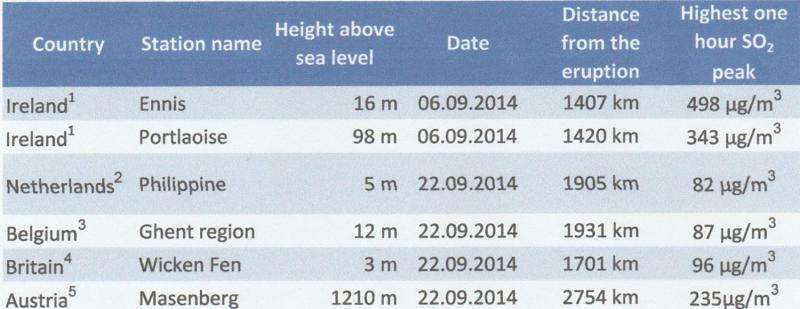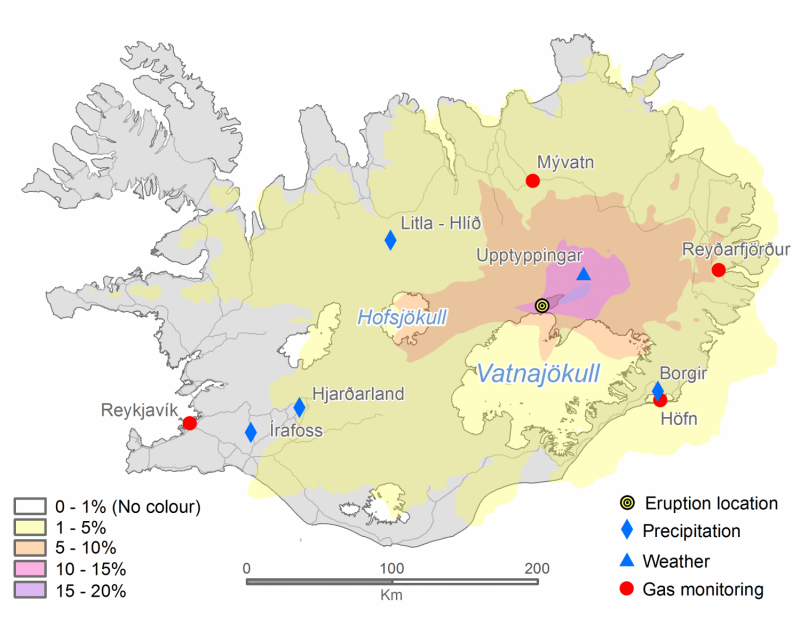Eruption of Bardarbunga volcano in Iceland spread SO2 pollutants over Europe

The six month long eruption of the Bardarbunga volcano (31 August 2014?27 February 2015 ) was the largest in Iceland since the devastating Laki eruption of 1783-84, producing around 1.6 km3 of lava, covering an area equivalent to Manhattan Island.
The eruption caused total Sulphur dioxide (SO2) emissions of nearly 12m tonnes, which exceeded the total SO2 emitted in Europe in 2011. In Iceland, concentration of SO2 exceeded the 350 µg m-3 hourly average health limit over much of the country for days to weeks. However, the effects of the volcano were not confined to Iceland - many parts of Europe also saw high SO2 levels.
Researchers were initially concerned that the SO2 emissions would be much higher, which would have caused serious health problems throughout Iceland and perhaps Europe.
Lead researcher, Professor Sigurdur Gislason (University of Iceland) said
'In the end we were lucky, but at the end of September we were getting pretty scared. Eight thousand years ago - which is nothing in geological time - Bardarbunga experienced an eruption even bigger than that of the 1783-84 Laki eruption. So knowing the history, we were worried that we would see a comparable event. Laki killed around 10,000 people in Iceland (20% of the Icelandic population), and the resultant SO2 pollution is thought to have affected tens of thousands in Europe, especially in the Britain, France and the Netherlands'
Writing in the peer-reviewed journal Geochemical Perspectives Letters (the journal of the European Association of Geochemistry), a group of Icelandic researchers has detailed the environmental effects of the Bardarbunga eruption.
Working in Iceland, and with environment agencies in several European countries, they were able to show that the SO2 levels rose significantly in the wake of the eruption. Monitoring stations in Ireland showed high SO2 spikes, with SO2 levels exceeding the European limits for the protection of human health on 6th September.Even at an altitude of 1210 meters in the Austrian Alps, SO2 levels spiked at 235 µg m-3. This is around 60% of permitted levels, and nearly 50 times the normal background level of around 5 µg m-3

The researchers stress that for most of Europe, the effects on health would have been minimal, given that the SO2 exposure was not prolonged.
According to lead Sigurdur Gislason:
'This was the biggest volcanic eruption in Iceland since the Laki eruption 200 years ago, which was an order of magnitude bigger. In 2014-15 most of Iceland, especially North Iceland, experienced gas pollution. However this was away from most inhabited areas.
We were also lucky with the timing, and with the weather, which tended to minimize the overall effects in Iceland, but also elsewhere on mainland Europe. The average wind speed is higher in winter than summer, thus the Bardarbunga eruption produced fast-dispersing plumes. Because of reduced autumn-winter sunlight hours, a smaller per cent of emitted SO2 had the potential to be oxidised under dry conditions to H2SO4 - sulphuric acid. During winter there is therefore greater environmental and human health risk from SO2 than from sulphuric acid aerosol particles due to reduced conversion efficiency, whereas in summer the aerosol particle effects may dominate.
Speaking to the EAG, Dr Anja Schmidt from the University of Leeds said "This eruption presented a truly remarkable opportunity for the scientific community to better understand and quantify how such large sulfur dioxide emissions affect regional climate, the environment and human health. Gislason and co-workers present several important datasets ranging from petrological estimates of the volcanic gas emissions to the degree of acidification of the environment. These data will be of great value to the scientific community and for future studies of this eruption."
More information: Geochemical Perspectives Letters v1, n1. DOI: 10.7185/geochemlet.1509
Provided by European Association of Geochemistry




















